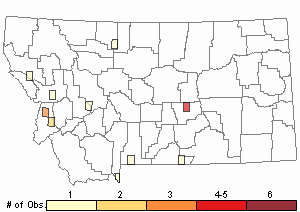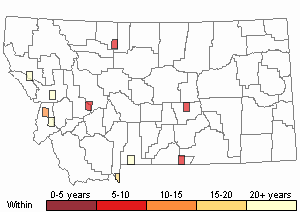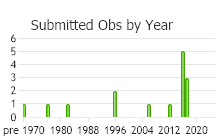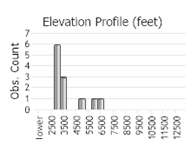View in other NatureServe Network Field Guides
NatureServe
Montana
Utah
Wyoming
Idaho
Wisconsin
British Columbia
South Carolina
Yukon
California
New York
Antler Twist Moss - Syntrichia papillosissima
Other Names:
Antler Moss,
Tortula papillosissima
General Description
Plants: Growing in loose to crowded tufts. Stems 10-25 mm long (FNA 2007), lacking central strand (Flower 1973). Acrocarpous.
Leaves: When dry, folded inwards and wound around stem; when wet, spreading 90 degrees to the stem and recurved; tongue-shaped to ovate, 2.5-4 x 1-1.6 mm, channeled to keeled. Margins smooth, compactly revolute from base to 3/4 to 7/8 around. Apex acute or broader-angled. Costa extending into a toothed, hyaline awn. Awn often brown or yellow-brown, its lower surface strongly papillose (FNA 2007).
Leaf Cells: In cross-section the leaf is 1-cell thick. Basal cells rectangular, abruptly distinguishable from the smaller distal cells, and narrower or quadrate at the margins. Mammillate distal cells, with 1-2 tall papillae per cell, are quadrate to polygonal, thick-walled (FNA 2007).
Diagnostic Characteristics
Syntrichia is differentiated from Tortula, in part, by the former’s large basal cells being sharply differentiated from the small distal cells (FNA 2007).
Tortula species with leaves turning red in 2% KOH solution, among other characteristics, have been placed in Henediella, Microbryum, or Syntrichia. Reduction in sporophyte development, such as capsule and peristome development, is prominent in Tortula but for which there is little evidence in Syntrichia FNA 2007).
Range Comments
Canada: BC; USA: AZ, CA, CO, ID, MT, NV, NM, OR, UT, WA; Mexico (Coahuila, Nuevo León); s Europe; c Asia (FNA 2007). In Montana: Broadwater, Carbon, Missoula, Park, Ravalli, and Sanders Counties (Elliott 2016).
Observations in Montana Natural Heritage Program Database
Number of Observations: 17
(Click on the following maps and charts to see full sized version)
Map Help and Descriptions
Relative Density

Recency



 (Observations spanning multiple months or years are excluded from time charts)
(Observations spanning multiple months or years are excluded from time charts)
Habitat
Dry soil and rock on warm, dry microsites in grassland and sagebrush steppe vegetation (Elliott 2016), sometimes on tree bases and exposed tree roots (Flowers 1973). Middle to high elevations (FNA 2007).
Reproductive Characteristics
Dioicous. Seta 12-18 mm long, brown. Capsules 3-5 mm, brown (FNA 2007).
No specialized vegetative reproduction (FNA 2007).
Stewardship Responsibility
References
- Literature Cited AboveLegend:
 View Online Publication
View Online Publication Elliott, J.C. and A.K. Pipp. 2018. A Checklist of Montana Mosses (1880-2018). Updated 3 January, 2020. Montana Natural Heritage Program, Helena, Montana. 73 pp.
Elliott, J.C. and A.K. Pipp. 2018. A Checklist of Montana Mosses (1880-2018). Updated 3 January, 2020. Montana Natural Heritage Program, Helena, Montana. 73 pp. Flora of North America Editorial Committee, eds. 2007. Flora of North America North of Mexico. Volume 27. Bryophytes: Mosses, Part 1. Oxford University Press, Inc., NY. xxi + 713 pp.
Flora of North America Editorial Committee, eds. 2007. Flora of North America North of Mexico. Volume 27. Bryophytes: Mosses, Part 1. Oxford University Press, Inc., NY. xxi + 713 pp. Flowers, S. 1973. Mosses: Utah and the West. Brigham Young University, Provo, Utah. 567 p.
Flowers, S. 1973. Mosses: Utah and the West. Brigham Young University, Provo, Utah. 567 p.
- Additional ReferencesLegend:
 View Online Publication
View Online Publication
Do you know of a citation we're missing? Elliot, J. C. 1993. Second checklist of Montana mosses. Unpublished report. U.S. Forest Service, Region 1. Missoula, MT. 45 pp.
Elliot, J. C. 1993. Second checklist of Montana mosses. Unpublished report. U.S. Forest Service, Region 1. Missoula, MT. 45 pp. Lawton, E. 1971. Keys for the Identification of the Mosses on the Pacific Northwest. Reprinted from 'Moss Flora of the Pacific Northwest'. Published as Supplement No. 2 of the Journal of the Hattori Botanical Laboratory. Nichinan, Miyazaki, Japan. 66 pp.
Lawton, E. 1971. Keys for the Identification of the Mosses on the Pacific Northwest. Reprinted from 'Moss Flora of the Pacific Northwest'. Published as Supplement No. 2 of the Journal of the Hattori Botanical Laboratory. Nichinan, Miyazaki, Japan. 66 pp. Lawton, E. 1971. Moss Flora of the Pacific Northwest. Hattori Botanical Laboratory. Japan: Yamabuki-cho, Shinjuku-ku, Tokyo. 362 pages plus appendices.
Lawton, E. 1971. Moss Flora of the Pacific Northwest. Hattori Botanical Laboratory. Japan: Yamabuki-cho, Shinjuku-ku, Tokyo. 362 pages plus appendices.
- Web Search Engines for Articles on "Antler Twist Moss"





